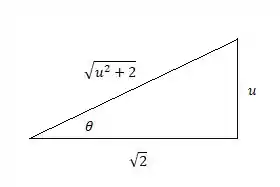Calcular a integral definida:
Passo 1
Vamos calcular a integral indefinida e depois utilizamos o Teorema Fundamental do Cálculo para aplicar os limites de integração:
Primeiro vamos fazer uma substituição para a integral ficar no formato para aplicar uma substituição trigonométrica:
Substituindo temos:
Passo 2
Para resolver essa integral vamos fazer uma substituição trigonométrica, temos que a expressão é da forma , nesse formato de expressão vamos fazer e utilizar a identidade trigonométrica :
Substituindo temos:
Agora usando a identidade trigonométrica:
Passo 3
Agora é fácil achar as primitivas da função, usando uma expressão da Tabela de Integrais Indefinidas:
Aplicando:
Passo 4
Calma, não terminou ainda, vamos ter que voltar para a variável original :
Temos que , ou seja, assim vamos usar o triângulo retângulo abaixo:

Assim o valor de é:
Pronto, ficamos então com:
Passo 5
Pronto, já encontramos a integral indefinida, agora é só calcular a integral definida usando o Teorema Fundamental do Cálculo:
Ficamos então com: